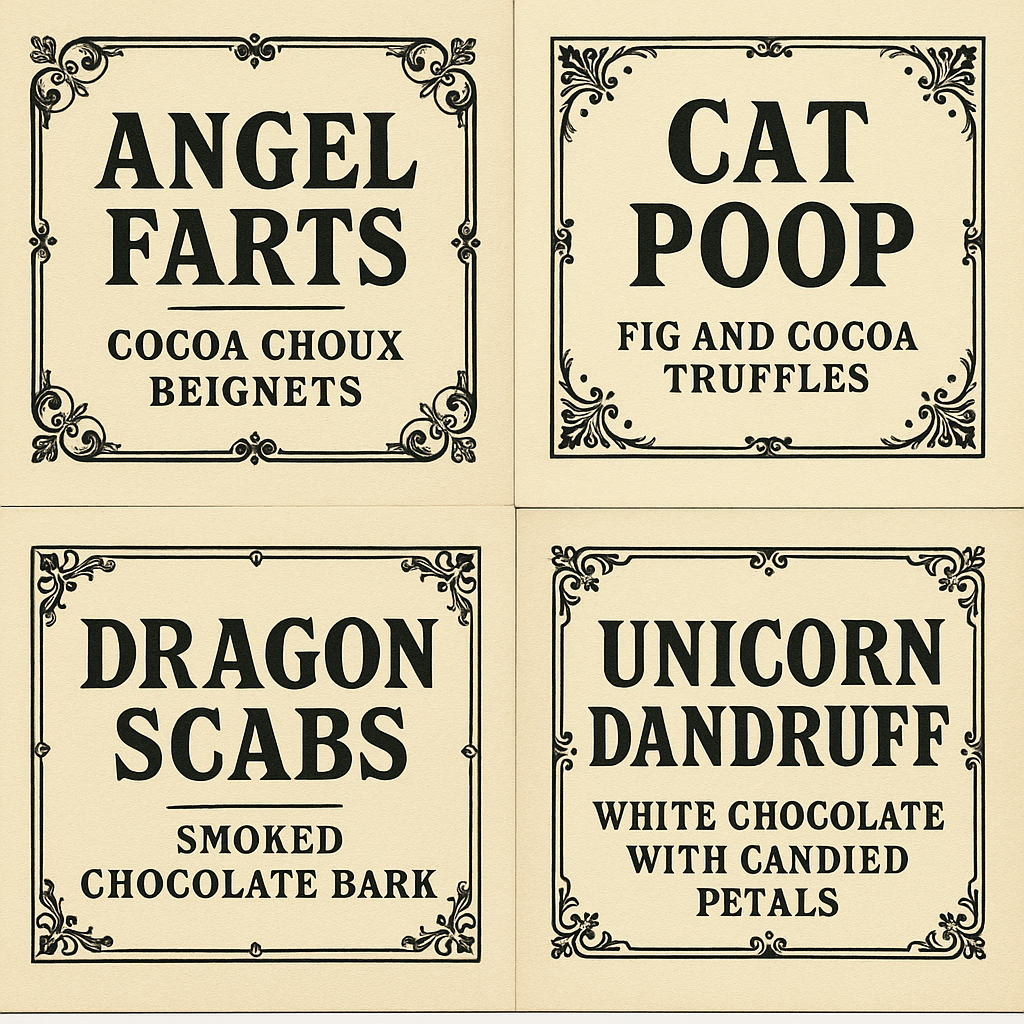Because sometimes, chocolate just needs to misbehave.
Chocolate is serious business. Origins, percentages, bean genetics, tempering curves — all the sacred stuff. But every now and then, I like to remind people that it’s also just… fun. Irreverent. Cheeky, even.

Because behind every great chocolate moment, there’s probably a nun, a pirate, or a cat involved.
The Line-Up: Chocolate Dishes with a Naughty Wink
🍩 Angel Farts (Pets de Nonne) – France
Yes, that’s the actual translation: “nun’s farts.” These airy fritters were born in French convents — like tiny choux puff doughnuts, dusted in sugar and served warm. I’ve given them a cocoa twist: deep-fried cocoa choux tossed in vanilla-cocoa sugar.
Historical Origin: 17th-century French convents
🐈 Cat Poop (Caca de Gato) – Portugal
Dark chocolate–coated candied orange peel, shaped into, let’s say… naturalistic forms. These aren’t your dainty Parisian orangettes — they’re rustic, wriggly, and look suspiciously like something the cat left behind. But one bite of that bittersweet citrus snap and you’re purring.
Historical Origin: Portuguese convent sweets meet Iberian citrus traditions
🐇 Rabbit Droppings (Crottes du Lapin) – France
Rustic Provençal chocolate almond clusters piped into suspiciously natural shapes, glazed with cocoa and honey. It’s a hedgerow treat with a naughty smile.
Historical Origin: French countryside, 19th century
🧙 Goblin Drool (Crème au Chocolat Enchantée) – England (with a touch of fantasy)
A Georgian-style boozy chocolate custard, infused with absinthe, mint, and dark cocoa. Serve in antique teacups or tiny cauldrons. It shimmers, it wobbles, it misbehaves.
Historical Origin: 18th-century English “chocolate cream”
🐉 Dragon Scabs (Écorce de Dragon) – French nautical fantasy
Inspired by early sailors’ “bark”: a mix of cocoa, sugar, spice, and pantry scraps. This modern version features puffed grains, treacle shards, smoked salt, and chilli. Crunchy. Mythical.
Historical Origin: Naval rations, 1700s
🦄 Unicorn Dandruff (Pellicule de Licorne) – Medieval modern whimsy
White chocolate shards with edible glitter, candied rose petals, violets, and sherbet fizz. Because why shouldn’t a posh medieval rave have dessert?
Historical Origin: Medieval flower confits + modern white chocolate
😈 Devil’s Belly Buttons (Boutons du Diable) – France/England
Sultry dark chocolate buttons filled with chipotle caramel and red pepper jelly. Inspired by Victorian spice drops and colonial cocoa confections — with a sulphurous wink.
Historical Origin: Victorian spice sweets
🤧 Chocolate Snot (Morve au Chocolat) – Nouveau naturopathie
Avocado, pistachio, and cocoa mousse, piped into specimen jars for full comedic effect. Think blancmange meets green juice, with 1960s health food swagger.
Historical Origin: Natural health revival, 1960s
🧹 Witch’s Armpit Whip (Fouet de Sorcière) – Tudor-style England/France
A Tudor-style syllabub: whipped cream, ale, chocolate, and a swirl of mugwort or rosemary. Served in pewter cups with a whiff of folklore.
Historical Origin: Tudor possets and herbal cordials
⛓️ Cocoa Clinkers (Tessons de Chocolat) – France
Chocolate tuiles with burnt sugar and coffee. Crisp, snappable, and suspiciously like something you’d sneak through customs.
Historical Origin: French patisserie meets wartime ingenuity
🐹 Mole Mole (Taupe Taupe) – Mexico
A mole mole! (Get it?) Dark chocolate mole sauce over sweet tamales, shaped like mole hills and dusted with toasted cocoa nib “dirt.”
Historical Origin: Oaxacan mole traditions
Troll Bogeys (Crottes de Troll) – Nordic
Sour cherry and sea buckthorn pâte de fruits dipped in chocolate, rolled in powdered pine sugar. Sour, sticky, glorious.
Historical Origin: Nordic wild berry confections
👁️ Pope’s Eyeballs (Yeux du Pape) – Italy
Cioccolatini ripieni shaped like eyes, filled with grappa and espresso ganache. Equal parts sacrilegious and seductive.
Historical Origin: Baroque Italian chocolate craft
🍑 Aphrodite’s Nipples (Mamelons d’Aphrodite) – Greece/France
Delicate chocolate-dipped figs stuffed with rose and honey ganache, topped with a candied pistachio “nipple.” Supposedly served at erotic banquets and romantic rites (or at least should have been).
Historical Origin: Inspired by Greek love feasts and French mendiants
⚰️ Cocoa Corpse Dust (Poussière de Cadavre au Cacao) – Gothic Revival
Black cocoa, powdered liquorice, and Victorian mourning biscuit energy. Traditionally served at wakes. Deliciously morbid.
Historical Origin: Victorian funeral customs
🧟 Zombie Bark (Écorce de Zombie) – Caribbean/Tiki fusion
Chocolate bark with rum-soaked fruit, burnt sugar, jerk spices and smoked salt. Inspired by rum cakes and zombie cocktails.
Historical Origin: Afro-Caribbean roots + Tiki culture
Why Bother With All This?
Because food should make us laugh. It should surprise us. It should carry history in its belly and mischief in its mouth.
As a chocolatier, I’ve spent years studying the sacred — single-origin beans, ancient fermentation, sacred rituals. But chocolate has always had a playful side. Think of the first child who smeared it on their face. Or the monk who slipped extra cocoa into a “health tonic” and called it medicine.
These dishes celebrate that joyful, subversive side.
Real history. Real flavour. Ridiculous names that make schoolkids snort and grown-ups smile guiltily into their napkins.
Want to Try Them?
I’ll be releasing full recipes and tasting notes for some of these on the Coeur de Xocolat blog and YouTube channel. Let me know which one you’d like me to demo first — or find me at the next chocolate festival. I might just have a sample of Goblin Drool or Aphrodite’s Nipples with your name on it.
Let’s bring a little mischief back to cocoa — one pet de nonne at a time.

